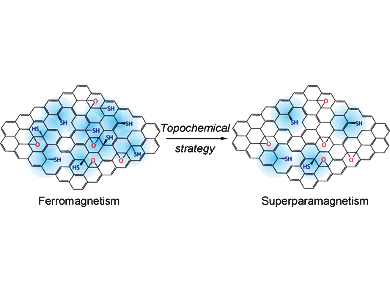The synthesis of graphene-based systems that show large magnetoresistive effects at ambient temperatures remains a challenge. Changzeng Wu and a team from the Chinese Academy of Sciences and the University of Science & Technology of China have developed a strategy for the fabrication of a superparamagnetic reduced graphene oxide with a large, low-field negative magnetoresistance at room temperature.
Reduced graphene oxide (rGO) possesses nontrivial sp-electron magnetism. Introduction of functional groups covalently bound to the carbon framework can result in ferromagnetism. Wu´s team modified rGo with thiol groups by reaction with H2S gas. This rGO with a high sulfur concentration is ferromagnetic. Mild oxidation with oxygen gas resulted in partial removal of the thiol groups, and led to a rGO with low sulfur concentration (LS-rGO) that is superparamagnetic. The magnetic behavior changes as the number of unpaired spins decreases and the magnetic domains reach a critical size as the number of thiol groups is reduced and thus interact less.
Further studies showed that LS-rGO has a large low-field negative magnetoresistive effect at room temperature (–8.6 %; 500 Oe; 300 K). This phenomenon occurs as the independent ferromagnetic domains align in the presence of an external magnetic field, and this results in an increased electron-tunneling probability.
- Superparamagnetic Reduced Graphene Oxide with Large Magnetoresistance: A Surface Modulation Strategy,
Jing Peng, Yuqiao Guo, Haifeng Lv, Xinyu Dou, Qi Chen, Jiyin Zhao, Changzheng Wu, Xiaojiao Zhu, Yue Lin, Wei Lu, Xiaojun Wu, Yi Xie,
Angew. Chem. Int. Ed. 2016.
DOI: 10.1002/anie.201511436




